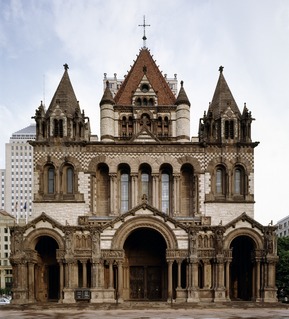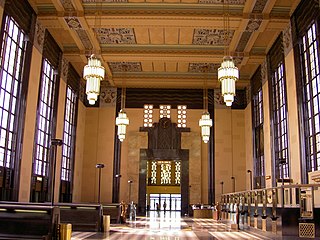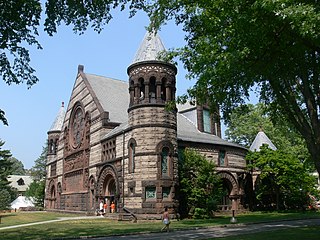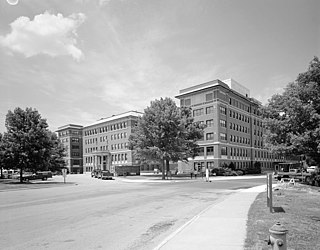Related Research Articles

Richardsonian Romanesque is a style of Romanesque Revival architecture named after the American architect Henry Hobson Richardson (1838–1886). The revival style incorporates 11th and 12th century southern French, Spanish, and Italian Romanesque characteristics. Richardson first used elements of the style in his Richardson Olmsted Complex in Buffalo, New York, designed in 1870. Multiple architects followed in this style in the late 19th century; Richardsonian Romanesque later influenced modern styles of architecture as well.

Charles Keck was an American sculptor from New York City, New York.

Gilbert Stanley Underwood (1890–1960) was an American architect best known for his National Park lodges. Born in 1890, Underwood received his B.A. from Yale in 1920 and a M.A. from Harvard in 1923. After opening an office in Los Angeles that year, he became associated with Daniel Ray Hull, a landscape architect, of the National Park Service. This led to a commission with the Utah Parks Company of the Union Pacific Railroad which was developing the parks in hopes of producing destinations for travelers. During this time Underwood designed lodges for Cedar Breaks National Monument, Zion National Park, Bryce Canyon National Park, and the North Rim of the Grand Canyon National Park. His surviving Utah Parks Company buildings are considered exceptional examples of the Rustic style of architecture, and are all listed on the National Register of Historic Places. In addition, Underwood was contracted to design Yosemite National Park's The Ahwahnee, also on the National Register and probably his greatest triumph in the Rustic style.

Kirtland Kelsey Cutter was a 20th-century architect in the Pacific Northwest and California. He was born in East Rockport, Ohio, the great-grandson of Jared Potter Kirtland. He studied painting and illustration at the Art Students League of New York. At the age of 26 he moved to Spokane, Washington, and began working as a banker for his uncle. By the 1920s Cutter had designed several hundred buildings that established Spokane as a place rivaling Seattle and Portland, Oregon in its architectural quality. Most of Cutter's work is listed in State and National Registers of Historic Places.

Shepley, Rutan and Coolidge was a successful architecture firm based in Boston, Massachusetts, operating between 1886 and 1915, with extensive commissions in monumental civic, religious, and collegiate architecture in the spirit and style of Henry Hobson Richardson.

John Charles Tarsney was an American politician from Missouri and an Associate Justice of the Oklahoma Territory Supreme Court (1896-1899). He then returned to Kansas City, Missouri, where he had a private law practice until he died in 1920.

William Appleton Potter was an American architect who designed numerous buildings for Princeton University, as well as municipal offices and churches. He served as a Supervising Architect of the Treasury from 1874 to 1877.

Frederick Clarke Withers was a successful English architect in America, especially renowned for his Gothic Revival ecclesiastical designs. For portions of his professional career, he partnered with fellow immigrant Calvert Vaux; both worked in the office of Andrew Jackson Downing in Newburgh, New York, where they began their careers following Downing's accidental death. Withers greatly participated in the introduction of the High Victorian Gothic style to the United States.

Louis Singleton Curtiss was a Canadian-born American architect. Notable as a pioneer of the curtain wall design, he was once described as "the Frank Lloyd Wright of Kansas City". In his career, he designed more than 200 buildings, though not all were realized. There are approximately 30 examples of his work still extant in Kansas City, Missouri where Curtiss spent his career, including his best known design, the Boley Clothing Company Building. Other notable works can be found throughout the American midwest.

Mineral Hall in Kansas City, Missouri is a historic building constructed in 1903. An elaborate example of Prairie School architecture by Louis Singleton Curtiss, it originally served as a residence.

George M. Coombs was an American architect from Maine.

Charles Henry Page (1876–1957) was an American architect. He and his brother Louis Charles Page (1883–1934) founded the Texas firm of Page Brothers, Architects. The firm achieved great recognition when they were commissioned to design the Texas State Building for the 1904 Louisiana Purchase Exposition. The Pages also designed many courthouses and other buildings across Texas.

The Western Branch of the National Home for Disabled Soldiers was established in 1885 in Leavenworth, Kansas to house aging veterans of the American Civil War. The 214-acre (87 ha) campus is near Fort Leavenworth, and is directly adjacent to Leavenworth National Cemetery, south of Leavenworth town. The home features about 82 contributing building resources, constructed between the 1880s and the 1940s. It is now part of the Department of Veterans Affairs Eisenhower Medical Center.
David Frederick Wallace was an architect and brother of First Lady of the United States Bess Truman.

Alfred Edward Barnes was an architect from Kansas City, Missouri. He was a partner with Henry F. Hoit and Edwin M. Price in the leading architectural firm of Hoit, Price and Barnes.
Ludlow and Peabody was an American architectural firm with offices in New York City formed by partners Charles S. Peabody and William Orr Ludlow in 1909. The firm continued in practice under that name until 1935.

The Douglas County Courthouse in Lawrence, Kansas is a three-and-a-half-story stone building built in 1903.
Otis Berthoude Gunn was a railroad engineer and Kansas state senator who received an appointment to serve as a major in the Fourth Volunteer Kansas regiment in the Union Army during the American Civil War, and later in the Tenth Kansas Infantry. He served on governor George F. Robinson's staff. The Historical Society of Kansas has a collection of his and his family's papers.

Bowd–Munson Company was an architectural firm in Lansing, Michigan. The firm was a partnership between Edwyn A. Bowd and Orlie Munson.
George E. McDonald was an architect in the United States. He is credited with designing several courthouses listed on the National Register of Historic Places:
References
- ↑ "American Art Annual". 1903.
- 1 2 3 4 5 6 7 "Frederick C. Gunn Papers (K0305)" (PDF). State Historical Society of Missouri. Retrieved 2018-11-27.
- 1 2 3 4 George Creel; John Slavens (1902). "Frederick C. Gunn". Men Who Are Making Kansas City. Kansas City, Missouri: Hudson-Kimberly – via Vintage Kansas City: Men Who Made Kansas City.
- ↑ "The Frank Lloyd Wright of Kansas City". KC History.
- ↑ David Sachs. "Douglas County Courthouse". SAH Archipedia. Society of Architectural Historians.
- 1 2 David Sachs. "Chapel of the Veterans". SAH Archipedia. Society of Architectural Historians.
- ↑ "Jackson County Courthouse".
- ↑ "Rock Island County has spent more than $200,000 on efforts to raze old courthouse as demolition remains stalled".